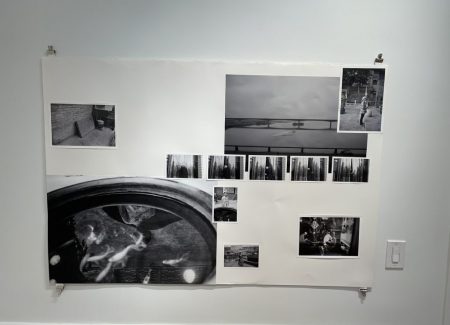JTF (just the facts): A total of 22 photographic works, variously framed/unframed, and hung against white walls in the single room gallery space.
The following works are included in the show:
- 1 archival pigment print on fibre paper, 2013, sized 28×18 inches, in an edition of 5+2AP
- 8 archival pigment prints on fibre paper, 2015, each sized 8×8 inches, in editions of 8+2AP
- 2 archival pigment prints, 2015, each sized 30×30 inches, in editions of 5+2AP
- 3 archival pigment prints on fibre paper, 2015, each sized 13×8 inches, in editions of 8+2AP
- 2 archival pigment print contact sheets, 2015, each sized 15×12 inches, in editions of 8+2AP
- 3 archival pigment prints on fibre paper, 2014, 2015, each sized 16×11 inches, in editions of 8+2AP
- 1 collage of 5 individual archival pigment prints on cotton paper, 2015, sized 28×56 inches, unique
- 1 collage of 14 individual archival pigment prints on cotton paper, 2014, sized 28×56 inches, unique
- 1 collage of 12 individual archival pigment prints on cotton paper, 2015, sized 28×56 inches, unique
- installation of photo archive in storage boxes (on table)
(Installation shots below.)
Comments/Context: Given the massive economic and social transformations that have taken place in China over the past few decades, it is not altogether surprising that many of the photographic projects from this period have focused on change. And wholesale change has indeed come in many forms: urban change, rural change, infrastructure change, geographic and environmental change, political change, and even personal change, in terms of everything from family structures to personal expression.
Documenting change is actually harder than it sounds, as it is often a case of trying to understand a complex process of replacement. Something new takes the place of something old, and so the shiny new thing is what we naturally focus our attention on. But what is overlooked, left behind, left to decay, or simply unable to adapt to the new reality can also be important, as is the moment of transition, when old and new lie in immediate, inescapable friction.
Hai Zhang’s Aged Innocence series tries to get out far beyond the bright lights and prosperous bustle of the big modern coastal Chinese cities to see how life in the countryside has been changing. Between 2013 and 2017, he made extended trips back to China (he now lives in New York), bringing the split perspective of insider and outsider to his task. His photographic results are consistently patient, and perhaps more modest and meditative than we might have expected, taking in some of the subtleties of change rather than the obvious broad strokes.
Three large collages find Zhang aggregating different facets of change into more complex formal arrangements. In one, a hulking industrial factory in Inner Mongolia dissolves into an enveloping puff of white smoke, while traditional workers (in the factory lunchroom) are flanked by the trappings of fashion and celebrity-conscious identity. In another, timeless temple rhythms (including a reflected portrait in a fish bowl) are matched by massive river bridges, plastic sheeting covering doors, and furry mascots. And in a third, formal echoes jump from past to present, linking human gestures across time, with traditional cart drivers and egg sellers faced with a future where many peer in through the modern windows from the outside.
Many of Zhang’s photographs, both in black-and-white, and in color, look back to Chinese eternals – the scale and power of the major rivers, the presence of horses and sheep in the rural countryside, and the respect paid to spiritual traditions. But when Zhang captures the tensions between new and old, his images have more simmering energy. Two contact sheet works find this point of uneasy juxtaposition, where the dry fields of new vineyards are interrupted by children playing, and the icy waters and waves of the wintertime North are broken up by sleek concrete bridges. The same idea takes a different form in Zhang’s understated images of Xi’an, where crumbling ancient buildings have been overtaken by new greenery, the flowers and leaves interjecting points of optimistic color into the otherwise muted grey architecture.
It’s clear that Zhang prefers applying a quietly positive outlook to his home country; even a bleary grey view of Wuhan is enlivened by an energetic flock of birds. His view of the changes he has found is understated, but the prevailing mood is one of coexistence and renewal, rather than mawkish nostalgia. His photographs readily acknowledge the transformations taking place, and look out for those overlooked moments that speak to connection rather than estrangement.
Collector’s POV: The works in this show range in price from $500 to $3500, based on size. Zhang’s work has little secondary market history at this point, so gallery retail likely remains the best option for those collectors interested in following up.















